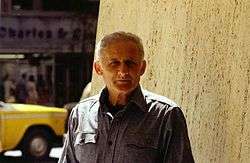Yechiel Shemi
| Yechiel Shemi | |
|---|---|
|
Yechiel Shemi | |
| Born | 1922 |
| Died | October 31, 2003 |
| Nationality | Israeli |
| Awards |
Sandberg Award Israel Prize for sculpture |
Yechiel Shemi (Hebrew: יחיאל שמי ) (1922-2003) was an Israeli sculptor. His environmental sculptures are displayed in open spaces around the country.[1]
Biography
In 1959-1961, Yechiel Shemi studied art in Paris. In 1977-1979, he taught sculpting and lectured on environmental sculpture at Oranim Teachers College. He also taught at the Technion in Haifa and the Ein Hod artist's colony. Shemi was a member of New Horizons group.[2]
After a show in the United States in the 1960s, the Museum of Modern Art acquired his work. Shemi was the first Israeli artist to have his work purchased by the MoMa.[3]
Shemi won the Sandberg Prize in 1981 and the Israel Prize for sculpture in 1986. In 1966 and 1997, the Tel Aviv Museum of Art mounted exhibitions of his work.[4]
Haifa, Bet Haarava 1922- 1948
Yehiel Shemi, (born Yehiel Stizberg), was born in 1922, to parents Moshe and Esther Stizberg. When he was two months old Yehiel with his family immigrated to the Mandate Israel and settled in Haifa. At the age of 14 he joined a youth movement called "The Working Camps". It was at this time that he started studying art with Paul K. Henich. In 1938 Stizberg was one of the founders of Kibbutz Beit HaArava which is located north of the Dead Sea. Alongside his agricultural work, Stizberg was interested in art. First he created landscape drawings and paintings, but then moved onto sculpting.
In 1942 Stizberg joined his friend Yitzhak Danziger's studio where he painted for 3 months. In 1945 Stizberg changed his last name to Shemi and joined the HeHalutz Movement as a courier activist. Up until 1948 Shemi continued as a missionary in Italy, France and Egypt to fulfill his job. Shemi then went to New York as a missionary where he studied with Chaim Gross, there Shemi was exposed and became acquainted with modern art and art history.
Artist in Kibbutz, Kabri 1949-1955
During the independence war Kibbutz Bet Haarava has abandoned and since Shemi was in New York at the time his artwork that was left in the kibbutz was abandoned or got lost. In 1949 after Shemi came back from the states he founded and lived in Kibbutz Kabri, Israel in the Galil. During the years 1950-52 Shemi worked as the kibbutz secretary and worked with Avigdor Stematsky and Joseph Zaritsky. He was influenced by them and in 1952 he became a member of New Horizons Group. In 1954 (the year he won a Dizengoff Prize) the members of the Kibbutz decided that Shemi would be able to work solely on his sculpting and art, assuming that his art work would bring money into the Kabri Kibbutz.
Injured Bird 1955-1961
In the mid 1950s Shemi's artwork changed drastically, one of the changes he made was changing his material for his sculptures from wood and stone to metal materials. His first metal bird sculpture was made in 1955. During the years 1955-1957 Shemi created a series of sculptures of abstract figures of animals and humans. A few of these sculptures were exhibited in the seventh exhibition of New Horizons that opened in 1957 at the Independence Hall (Israel). Exhibiting some 30 sculptures by Shemi. During 1957-1956, Shemi created the sculpture group "Nest".
Ripped Iron 1962- 1970
This period was one of the most productive of his life. In 1962 Shemi began to create expressive works. The raw material used in these sculpture was mostly scrap metal. During the 1960s Yehiel Shemi introduced his assemblage sculpture in the solo exhibitions at Centre for Fine Arts, Brussels in 1964. Yehiel Shemi had additional solo exhibitions at the Tel Aviv Museum of Art in 1966 and at the Israel Museum in 1967. Shemi also created at this time two large public statues. In 1966 Shemi moved to Kibbutz Gadot for a half year.
1970-1992
In the late 1960s and throughout the 1970s Shemi changed the technique used in his sculptures. Instead of using ready-made objects, he reduced his art to geometric shapes. In 1981 Shemi was awarded the Sandberg Prize from the Israel Museum. In 1986, the Israel Prize for sculpture, together with Batya Lishansky. In 1988 Adam Baruch published the book "Yehiel Shemi: Sculptures" and a solo exhibit was help in the Ramat Gan Museum of Art.
Last years
In 1995 a retrospective exhibit was held at the Tefen Sculpture Garden. In 1997 a retrospective exhibit of his works was held at the Tel Aviv Museum of Art with a biographical catalog by Michael Sgan-Cohen. In 1998 the "Yehiel Shemi Papers" was published by the author Agassi, which is based on a series of conversations with Shemi. He died on October 31, 2003. .
Awards and recognition
- 1954 Dizengoff Prize for Painting and Sculpture, Municipality of Tel Aviv-Jaffa
- 1966 Milo Club Prize
- 1981 Sandberg Prize for Israeli Art, Israel Museum, Jerusalem
- 1986 Israel Prize for Lifetime Achievement in Sculpture
- 2000 The Mendel and Eva Pundik Foundation Prize for an Israeli Artist, Tel Aviv Museum of Art, Tel Aviv
Education
- 1937-38 Reali High School, Haifa
- 1959-1961 advanced studies, Paris, France
- 1941 Advanced studies in sculpture with Itzhak Danziger, Tel Aviv
- 1940s Studied sculpture with Chaim Gross, New York
Teaching
- 1977-79 Oranim Art Institute, Tivon, sculpture and environmental sculpture
- 1977-78 Art School, Ein Hod, sculpture
- 1977-79 Technion, Haifa, Lecturer on environmental design
See also
References
External links
- Yechiel Shemi collection at the Israel Museum. Retrieved July 2012
- "Yechiel Shemi". Information Center for Israeli Art. Israel Museum. Retrieved February 2012. Check date values in:
|access-date=(help) - Art of Yechiel Shemi at Europeana. Retrieved February 2012
